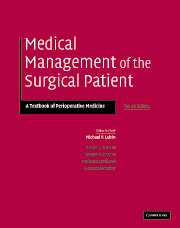Book contents
- Frontmatter
- Contents
- Editor biographies
- List of contributors
- Preface
- Introduction
- Part I Medical management
- 1 Anesthesia management of the surgical patient
- 2 Nutrition
- 3 Preoperative testing
- 4 Chronic medications around the time of surgery
- 5 Ethical considerations in the surgical patient
- 6 Cardiovascular disease
- 7 Postoperative chest pain and shortness of breath
- 8 Perioperative management of hypertension
- 9 Perioperative pulmonary risk evaluation and management for non-cardiothoracic surgery
- 10 Acute lung injury (ALI) and the acute respiratory distress syndrome (ARDS)
- 11 Postoperative pulmonary complications
- 12 Peptic ulcer disease
- 13 Liver disease
- 14 Inflammatory bowel disease
- 15 Postoperative gastrointestinal complications
- 16 Disorders of red cells
- 17 Assessment of bleeding risk in the patient with no history of hemostatic problems
- 18 Surgical issues affecting patients with hemotologic malignancies
- 19 Prophylaxis for deep venous thrombosis and pulmonary embolism in surgery
- 20 Blood transfusion/preoperative considerations and complications
- 21 Prevention of surgical site infections
- 22 Medical care of the HIV-infected surgical patient
- 23 Fever and infection in the postoperative setting
- 24 Surgery in the patient with renal disease
- 25 Postoperative electrolyte disorders
- 26 Diabetes mellitus
- 27 Disorders of the thyroid
- 28 Disorders of the adrenal cortex
- 29 Disorders of calcium metabolism
- 30 Pheochromocytoma
- 31 Rheumatologic diseases
- 32 Cerebrovascular disease
- 33 Management of the surgical patient with dementia
- 34 Neuromuscular disorders
- 35 Perioperative management of patients with Parkinson's disease
- 36 Delirium in the surgical patient
- 37 Surgery in the elderly
- 38 Obesity
- 39 Depression
- 40 Substance abuse
- 41 Care of the peripartum patient
- Part II Surgical procedures and their complications
- Index
- References
37 - Surgery in the elderly
Published online by Cambridge University Press: 12 January 2010
- Frontmatter
- Contents
- Editor biographies
- List of contributors
- Preface
- Introduction
- Part I Medical management
- 1 Anesthesia management of the surgical patient
- 2 Nutrition
- 3 Preoperative testing
- 4 Chronic medications around the time of surgery
- 5 Ethical considerations in the surgical patient
- 6 Cardiovascular disease
- 7 Postoperative chest pain and shortness of breath
- 8 Perioperative management of hypertension
- 9 Perioperative pulmonary risk evaluation and management for non-cardiothoracic surgery
- 10 Acute lung injury (ALI) and the acute respiratory distress syndrome (ARDS)
- 11 Postoperative pulmonary complications
- 12 Peptic ulcer disease
- 13 Liver disease
- 14 Inflammatory bowel disease
- 15 Postoperative gastrointestinal complications
- 16 Disorders of red cells
- 17 Assessment of bleeding risk in the patient with no history of hemostatic problems
- 18 Surgical issues affecting patients with hemotologic malignancies
- 19 Prophylaxis for deep venous thrombosis and pulmonary embolism in surgery
- 20 Blood transfusion/preoperative considerations and complications
- 21 Prevention of surgical site infections
- 22 Medical care of the HIV-infected surgical patient
- 23 Fever and infection in the postoperative setting
- 24 Surgery in the patient with renal disease
- 25 Postoperative electrolyte disorders
- 26 Diabetes mellitus
- 27 Disorders of the thyroid
- 28 Disorders of the adrenal cortex
- 29 Disorders of calcium metabolism
- 30 Pheochromocytoma
- 31 Rheumatologic diseases
- 32 Cerebrovascular disease
- 33 Management of the surgical patient with dementia
- 34 Neuromuscular disorders
- 35 Perioperative management of patients with Parkinson's disease
- 36 Delirium in the surgical patient
- 37 Surgery in the elderly
- 38 Obesity
- 39 Depression
- 40 Substance abuse
- 41 Care of the peripartum patient
- Part II Surgical procedures and their complications
- Index
- References
Summary
Introduction
Surgical and anesthetic care have improved markedly in the last half century. It is likely that the greatest benefit of this improvement has been for the elderly population. Older patients can benefit from surgery that would not have been contemplated in the past; thus, patients are living longer and with a better quality of life than ever before.
The literature in surgical care of the elderly patient is extensive, growing rapidly and indicates that, with careful planning and care, the elderly can undergo surgery safely and with approximately the same risk as many younger patients. This section discusses the following topics as they pertain to the elderly population: (a) physiologic decrements of aging, (b) risks of surgery, (c) preoperative evaluation, (d) anesthesia, (e) common surgical procedures and (f) postoperative care.
Physiologic decrements of aging
Although physicians see many elderly patients who appear old and sick with many underlying health problems, a large percentage of the elderly population is quite well. These people can function entirely normally and have no limitations to their activities. Despite this degree of functional normality, however, all older people experience various decrements in physiologic function that are of importance in planning their care, particularly when they are under stresses such as surgery. These decrements make even healthy older patients more fragile and more likely to suffer postoperative complications and death than their younger counterparts. Physicians must take them into account in their evaluations.
The cardiovascular system has been studied and reviewed extensively.
- Type
- Chapter
- Information
- Medical Management of the Surgical PatientA Textbook of Perioperative Medicine, pp. 445 - 464Publisher: Cambridge University PressPrint publication year: 2006

